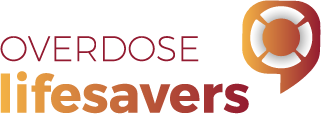
Gabrielle revives a man after neighbours ask her for help
Preferred Name: Gabrielle
Gender: Female
Age: Late 40s
Who is Gabrielle?
Gabrielle lives with her partner in an inner-south Melbourne suburb. She describes her ethnic background as ‘Australian’, but was born in New Zealand and her parents were born in Fiji and France. She works full time as a nurse. Gabrielle has extensive experience with take-home naloxone and has used it to revive people on many occasions. In her interview, Gabrielle describes take-home naloxone as something that can help people take responsibility for their drug use.
Brief Outline:
Gabrielle describes an occasion when she revived a man she hadn’t met before. A friend called her to ask for help, and she rushed downstairs from her unit with her take-home naloxone kit to find the man, who was experiencing an overdose, was unresponsive. She gave him the naloxone while her friend performed CPR (cardiopulmonary resuscitation). Injecting two ampoules of naloxone revived him, and paramedics who had been called by friends administered a third ampoule. This was one of many times Gabrielle has revived someone experiencing an overdose, either at work or with her peer group, and she actively encourages people to keep naloxone on hand, and to learn how to use it.
Within about 30 seconds of the second injection, he gave a cough and a bit of spluttering, and things were good. He was slightly aggressive when he started coming round, but I’d asked his girlfriend to start talking to him before he came to, so he would hear voices and wouldn’t be so confused. It’s the confusion that can make people agitated and angry. I had given him two ampoules of Narcan, and when the paramedics got there, they gave him a third.
When I’m attending to someone overdosing, unless it’s my partner, my emotions aren’t there; it’s like running on automatic. A lot of the time, I’m the one administering the CPR while somebody else gives the Narcan. People are scared about doing chest compressions, so I can talk someone through giving an injection while I’m doing chest compressions. Sometimes it’s a matter of needing both. Narcan will bring somebody around, but if they haven’t had blood circulating and oxygen, they may not be that great when they come around.
I keep my Narcan kit on top of the fridge. It has an overdose badge on it, but it’s like a large make-up bag, and in it there are fits, two different sizes of needles, swabs, my sharps container, and there is a little box with the ampoules and instructions inside it, in case it’s not me using it.
Friends who visit me all know where my Narcan kit is, and I’ve made sure that everybody who comes into the house who is going to use opiates knows how to use it, whether they’ve done overdose response training or not. We’re all pretty comfortable and confident with how to use Narcan. It’s part of taking responsibility for your own drug use.
Reflecting on her many experiences responding to overdose, Gabrielle emphasised the importance of encouraging more people to have naloxone on hand and learn how to use it. As she explained, ‘About a week and a half ago, a person overdosed in my block of units, and I live in public housing and it took a friend six different phone calls to find someone who had naloxone – and I’ve got a problem with that.’
The other day I got a call asking me to come and help someone downstairs from my unit. I grabbed my Narcan (naloxone) kit from the top of the fridge and ran down a couple of flights of stairs. When I got there a girlfriend of mine was administering CPR on this guy who I’d never met. People there had already called triple zero [emergency services]. He was non-responsive, not even responding to pain or anything, so I administered the Narcan. While the CPR continued, I injected a full ampoule of Narcan into the top of his leg, then after 90 seconds, a second one as I could see nothing was changing.
Within about 30 seconds of the second injection, he gave a cough and a bit of spluttering, and things were good. He was slightly aggressive when he started coming round, but I’d asked his girlfriend to start talking to him before he came to, so he would hear voices and wouldn’t be so confused. It’s the confusion that can make people agitated and angry. I had given him two ampoules of Narcan, and when the paramedics got there, they gave him a third.
When I’m attending to someone overdosing, unless it’s my partner, my emotions aren’t there; it’s like running on automatic. A lot of the time, I’m the one administering the CPR while somebody else gives the Narcan. People are scared about doing chest compressions, so I can talk someone through giving an injection while I’m doing chest compressions. Sometimes it’s a matter of needing both. Narcan will bring somebody around, but if they haven’t had blood circulating and oxygen, they may not be that great when they come around.
I keep my Narcan kit on top of the fridge. It has an overdose badge on it, but it’s like a large make-up bag, and in it there are fits, two different sizes of needles, swabs, my sharps container, and there is a little box with the ampoules and instructions inside it, in case it’s not me using it.
Friends who visit me all know where my Narcan kit is, and I’ve made sure that everybody who comes into the house who is going to use opiates knows how to use it, whether they’ve done overdose response training or not. We’re all pretty comfortable and confident with how to use Narcan. It’s part of taking responsibility for your own drug use.
While Gabrielle (F, late 40s, Vic, non-prescribed opioids) says she doesn’t feel her drug consumption carries a significant overdose risk, she makes sure to inject small amounts of heroin at a time, rather than giving herself one large dose.
Yeah, I don’t use benzos. So, a lot of people I know who have overdosed, it’s been a combination of heroin and other drugs. So I think that’s the reason why I haven’t overdosed. I was also … I had instilled into me right from the beginning that ‘two holes in the arm is better than one in the ground’ […] It’s a good way to look at things […] There’s been more than eight or 10 times, at least, where that theory has saved me.
Gabrielle (F, late 40s, Vic, non-prescribed opioids) speaks about administering naloxone during an overdose in her apartment building. She also instructed the other people present to help by doing other things such as CPR.
When I’m attending to someone overdosing, unless it’s my partner, my emotions aren’t there. I’m just running on automatic, like [I] become robotic […] A lot of the time, I’m the one administering the CPR while somebody else gives the Narcan. People are scared about doing heart compression, that sort of thing, so I can talk somebody through giving an injection while I’m doing heart compressions. Sometimes it’s a matter of needing both, and Narcan will bring somebody around, but if they haven’t had blood circulating and oxygen, [they may not be that great when they come around].
Also describing a group situation, Gabrielle (F, late 40s, Vic, non-prescribed opioids) tells the story of responding to an overdose in her apartment block, saying she needed to administer several doses before the person was revived. She and the other people present also responded to the overdose in other ways, for example, by performing mouth-to-mouth resuscitation and heart compressions.
When I was called [to an overdose] the other day, it was like, grab the kit and run down a couple of flights of stairs, and when I got there a girlfriend of mine was administering CPR on a guy that I’d never met. They had called triple zero and he was non-responsive. Just non-responsive, and wouldn’t respond to any sort of pain or anything, so I administered the Narcan, a full ampoule of Narcan into the top of his leg […] and after 90 seconds, a second one, and could see that nothing was changing. [But…] within like 30 seconds of the second one, he gave a cough and a bit of spluttering and things were good.
Gabrielle (F, late 40s, Vic, non-prescribed opioids) speaks about using communication strategies to reduce the confusion of a man revived with naloxone.
He started coming around slightly aggressive, but his girlfriend was with us and I had already asked her to start talking to him before he was coming to, so at least he could hear voices when he was coming around and wouldn’t be so confused. Because it’s the confusion that makes people agitated and angry […] a lot of the time they won’t admit to having overdosed, they’ll just say, ‘I was just really stoned,’ but when they’re blue and there’s no heartbeat and their girlfriend is crying in the corner, there’s not much you can do. You’ve got to do what you’ve got to do.
The cost of take-home naloxone is a concern for some participants such as Gabrielle (F, late 40s, Vic, non-prescribed opioids) who argues that prices should be kept down.
In early 2019 the federal Government of Australia announced the two-year trial of a national take-home naloxone program focussed on expanding naloxone availability for people thought to be at high risk of opioid overdose. The national program may have implications for the price of take-home naloxone in the future.
I haven’t had trouble accessing it via a GP because I do see a doctor regularly. If someone wasn’t seeing a doctor regularly, that could be different, but because I do, it’s easy. [Recently I was sick in hospital and] I had a pharmacy student talking to me about it. […] She was doing projects to do with being able to buy it over the counter and she had drawn up some posters so that people could be aware that it was available in the pharmacy that she worked at. If memory serves me right, it wasn’t cheap: $20 or $30 or something like that. I think it would be good if it could be made less expensive. It’s not like people are going to be getting that drug to take it for themselves, it’s a public service as such. So if the cost could be kept down, it would be easier for some people to get. Because not everybody […] sees a GP regularly and [the price should not be a] barrier. They have to have access to the Narcan.
Likewise, Gabrielle (F, late 40s, Vic, non- prescribed opioids) was searched by police who ‘didn’t worry’ about her naloxone after she explained what it was.
I do have a [criminal] record and […] I was on the side of the road in a car when the police stopped, and they ended up searching the whole car. They [saw the naloxone in my bag] and asked what it was. Because I’ve got two pieces of paper in there, one of them is how to give naloxone, so when they saw that, they just put it away. They didn’t worry about it any more […] They thought they were on to something at first and then realised it wasn’t anything illegal and I had literature in there […] so when they saw that it was an actual naloxone kit, they sort of put it down and, by that stage, they already knew that the only things in there were naloxone ampoules.

